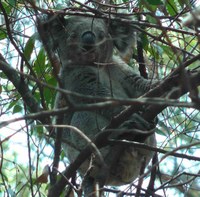Plateau Koalas Project
Koala Habitat Corridors Vegetation Mapping Dorrigo Plateau
DORRIGO PLATEAU CORRIDOR DIGITAL MAPPING
AND KOALA RESTORATION PROJECT
About the project:
This two-year project received grant funding from the Australian Government and includes mapping of vegetation in three biodiversity corridors on the plateau, conserving and adding to existing habitat through regeneration and enrichment planting of 2560 plants along and adjacent to the Mackay’s Creek Rd corridor, and fencing habitat from stock with wildlife friendly fencing.
PROJECT MAPS
Dandarrga Corridor 1 DOWNLOAD PDF 11.6mb |
Dandarrga Corridor 2 North DOWNLOAD PDF 12.3mb |
Dandarrga Corridor 2 South DOWNLOAD PDF 12.3mb |
|
Dandarrga Corridor 3 |
Dandarrga Corridor Overview - No Fauna DOWNLOAD PDF 14.7mb |
Dandarrga Corridor Overview - |
Why is mapping important?
The Dorrigo Plateau is a unique landscape. It lacks comprehensive digital vegetation mapping, so we started with the most important bits: the regional biodiversity corridors. Vegetation mapping is crucial for understanding plant communities and planning effective landscape rehabilitation. It helps landholders select the right native species mix for restoring disturbed areas and plan their land use accordingly.
Why are corridors important for Koala conservation?
Koalas require large, interconnected habitats for feeding, movement, and breeding. Wildlife corridors provide safe passage across the landscape, connecting larger habitat areas such as National Parks. These corridors are crucial for enabling koala populations to safely navigate when environmental threats such as droughts, fires, floods, and climate change mean their home range is no longer suitable. Koalas are a flagship iconic species but for every koala, there are thousands of other lesser-known species that are just as important that will also benefit.
ADDITIONAL PROJECT RESOURCES
PLANT COMMUNITY TYPE DESCRIPTIONS Table.pdf
PLANT COMMUNITY TYPES BOOKLET.pdf 9.9mb
COMMON EUCALYPTS of the DORRIGO PLATEAU.pdf 1.7mb
What is a Plant Community Type?
Plant community types (PCT’s) represent the most detailed category within the NSW vegetation classification hierarchy. They identify and characterise consistent groupings of native plant species, considering factors like soil quality, temperature, moisture, and other environmental variables. These communities are defined by recurring combinations of trees, shrubs, and ground cover plants that commonly grow together. Each PCT falls under a vegetation class, which is assigned to a particular vegetation formation (eg Rainforest, Woodland).
What can landholders do to help koala conservation?
 |
EVALUATE: Assess your property's current habitat and pinpoint areas suitable for habitat restoration. Consider factors such as vegetation types, connectivity to existing habitats, and access to water sources. PLAN: Create a restoration plan tailored to your property. This could range from mapping different vegetation zones to a comprehensive property plan that integrates productive aspects like grazing. If you're new to this, reach out to Landcare or local Bush Regeneration contractors for guidance. PLANT: Use our Koala Habitat Species List as a guide.. You can begin with small steps and expand your project gradually. Visit the Dorrigo Landcare Nursery at the showground for expert advice. Collaborate: Share plans with neighbouring landholders, and environmental groups to establish wildlife corridors and enhance koala habitat connectivity. MONITOR: Regularly assess how effectively habitat restoration is progressing on your property. Keep an eye out for koalas and report any sightings to help track their presence across the landscape. |
|
|
 |
This project received grant funding from the Australian Government.
Threatened Species Commissioner, Department of Climate Change, Energy, the Environment and Water












